Common Surinam toad
The common Suriname toad or star-fingered toad (Pipa pipa) is a species of frog in the family Pipidae found in Bolivia, Brazil, Colombia, Ecuador, French Guiana, Guyana, Peru, Suriname, Trinidad and Tobago, and Venezuela. Its natural habitats are subtropical or tropical moist lowland forests, subtropical or tropical swamps, swamps, freshwater marshes, and intermittent freshwater marshes. It is threatened by habitat loss.
| Common Surinam toad | |
|---|---|
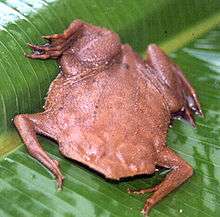 | |
| Scientific classification | |
| Kingdom: | Animalia |
| Phylum: | Chordata |
| Class: | Amphibia |
| Order: | Anura |
| Family: | Pipidae |
| Genus: | Pipa |
| Species: | P. pipa |
| Binomial name | |
| Pipa pipa | |
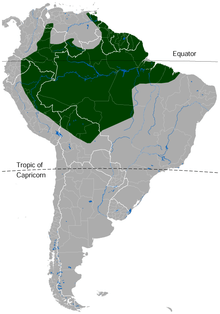 | |
| Suriname toad range.[2] | |
| Synonyms | |
* Pipa americana Laurenti, 1768 | |
Description
The common Suriname toad is similar in appearance to a mottled brown leaf, and is almost completely flat. Its feet are broadly webbed with the front toes having small, star-like appendages. Specimens of close to 20 cm (8 in) in length have been recorded, although 10–13 cm (4–5 in) is a typical size. The Suriname toad has minute eyes, no teeth, and no tongue.
Behavior
The Suriname toad is found in slow-moving streams and rivers throughout South America.
Diet
It is a predator and scavenger, capturing invertebrates and small fish with its star-fingered hands to eat, or swallowing dead creatures it comes across.[3]
Reproduction
Suriname toads are best known for their reproductive habits. Unlike the majority of toads, the males of this species do not attract mates with croaks and other sounds often associated with these aquatic animals. Instead, they produce a sharp clicking sound by snapping the hyoid bone in their throats.[4] The partners rise from the floor while in amplexus and flip through the water in arcs. During each arc, the female releases 3 to 10 eggs, which get embedded in the skin on her back by the male's movements. After implantation, the eggs sink into the skin and form pockets over a period of several days, eventually taking on the appearance of an irregular honeycomb. The embryos develop through to the tadpole stage inside these pockets, eventually emerging from the mother's back as fully developed toads, though they are less than an inch long (25 mm). Once they have emerged from their mother's back, the toads begin a largely solitary life.
After giving birth to the new toads, the mother slowly sheds the thin layer of skin that was used to birth them, and can begin the cycle again.[5]
Gallery
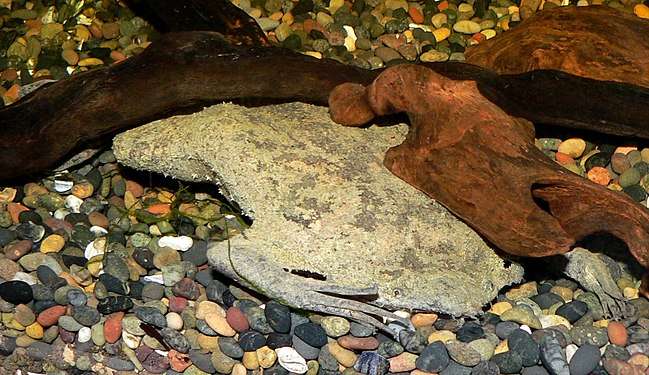 The gray shape is the Suriname toad.
The gray shape is the Suriname toad..jpg) A Suriname toad with eggs embedded in the skin
A Suriname toad with eggs embedded in the skin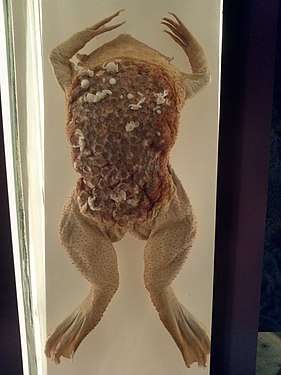 Museum specimen
Museum specimen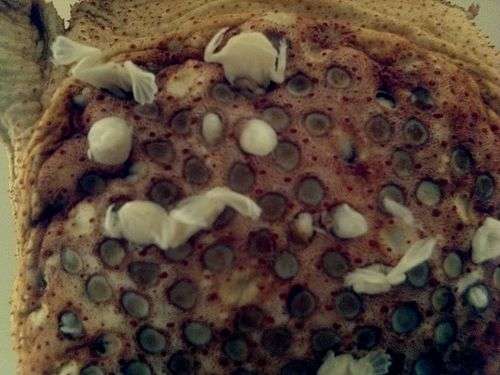 Museum specimen: closeup
Museum specimen: closeup
Cultural significance
The Surinam toad is commonly cited as an example of a trypophobia trigger. [6]
References
- IUCN SSC Amphibian Specialist Group (2015). "Pipa pipa". IUCN Red List of Threatened Species. 2015: e.T58163A61414791. doi:10.2305/IUCN.UK.2015-4.RLTS.T58163A61414791.en.
- IUCN (International Union for Conservation of Nature), Conservation International & NatureServe. 2010. Pipa pipa. In: IUCN 2015. The IUCN Red List of Threatened Species. Version 2015.2. "Archived copy". Archived from the original on 2014-06-27. Retrieved 2011-01-24.CS1 maint: archived copy as title (link). Downloaded on 10 July 2015.
- Surinam Toad
- Piper, Ross (2007), Extraordinary Animals: An Encyclopedia of Curious and Unusual Animals, Greenwood Press.
- https://www.wired.com/2013/12/absurd-creature-of-the-week-the-toad-whose-young-erupt-from-her-skin/
- "Do you have trypophobia? Unofficial phobia might make your skin crawl".
- La Marca, E., Azevedo-Ramos, C., Silvano, D., Coloma, L.A., Ron, S. & Hardy, J. 2004. Pipa pipa. 2006 IUCN Red List of Threatened Species. Downloaded on 23 July 2007.
External links
| Wikispecies has information related to Pipa pipa |
| Wikimedia Commons has media related to Pipa pipa. |
